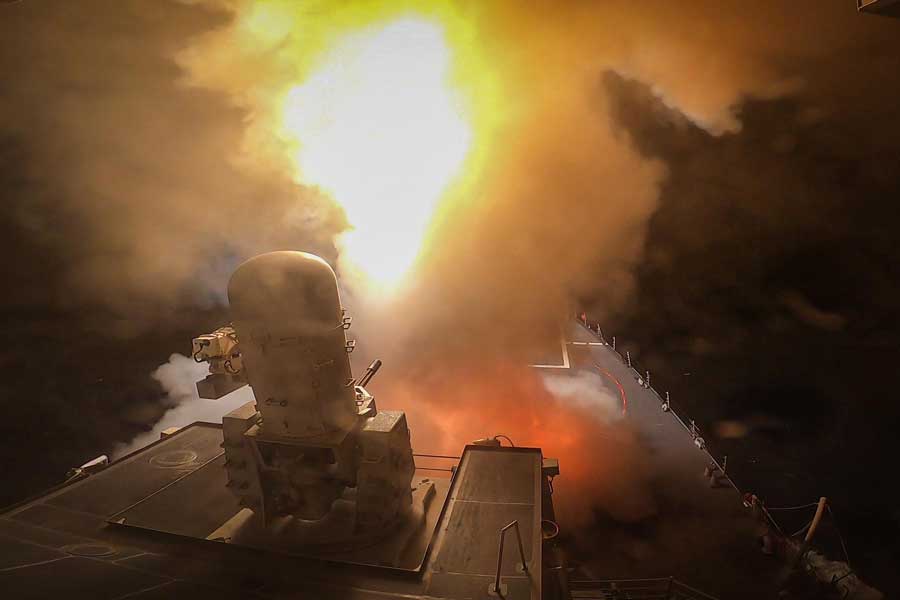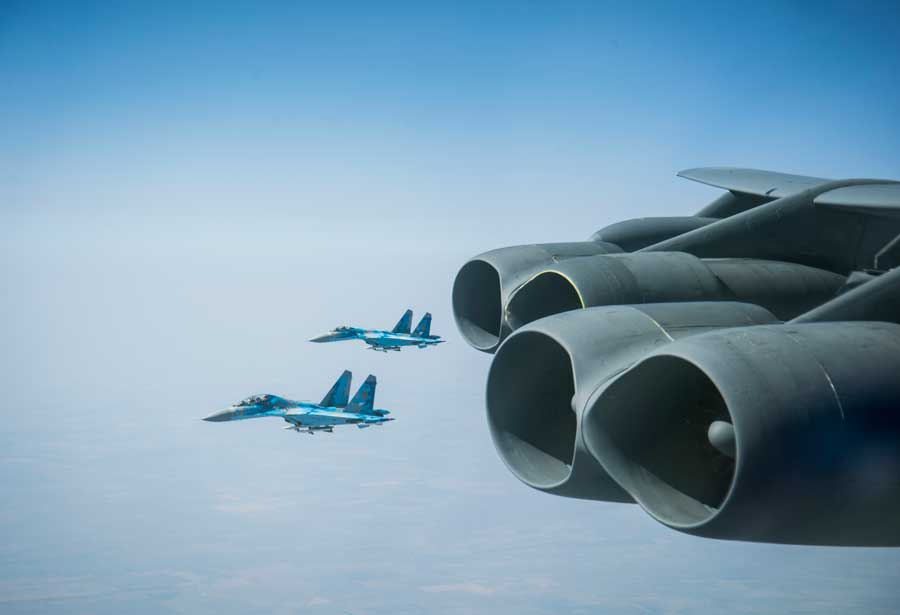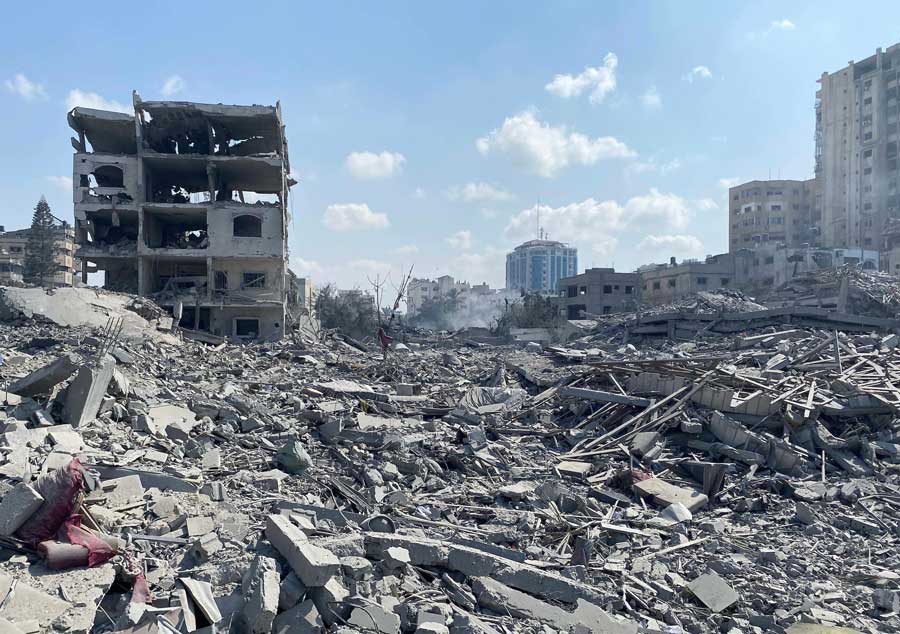Emissions War Escalates—Pollution From World’s Militaries in Spotlight at UN Summit Should international climate pacts require militaries to comprehensively report the amount of greenhouse gases they release into the atmosphere?
In the winter of 2022, Lennard de Klerk was running a carbon-neutral ecolodge in a tiny Hungarian town when Russia invaded neighboring Ukraine and hundreds of thousands of refugees crossed the border into Hungary.
De Klerk, a Dutch engineer who once ran a company that worked to reduce greenhouse gas emissions in Europe, had lived in Ukraine for three years and spoke the language. He could hear the fear in the voices of the refugees he and his husband hosted at their lodge.
It made him think: “What more can I do to help Ukraine?” de Klerk told The War Horse.
He decided that calculating the planet-warming emissions resulting from the war in Ukraine might motivate people who weren’t directly affected by the conflict to care more about it because greenhouse gases destroy “everyone’s climate,” he said. So he rounded up a group of former colleagues to calculate the emissions of everything from the fires triggered by bombing raids to the fuel consumed by Russian tanks to the tailpipe emissions of the cars of Ukrainians fleeing their homes.
The team then spent the next two years working on the first study ever to calculate the emissions from a war in real time.
Now, there are signs that the battle over military emissions is about to intensify.
Next month, de Klerk will lead a 90-minute panel discussion on wartime greenhouse gas emissions at the United Nations’ annual climate summit in Azerbaijan’s capital, Baku. It will be one of two panel discussions at the Nov. 11-22 conference during which a determined coalition of climate scientists, environmental groups and researchers hope to spotlight a controversy that has been simmering for more than a quarter of a century:
Should the world’s militaries be required to report the amount of carbon dioxide and other greenhouse gases they release into the atmosphere?
The coalition launched a lobbying campaign a few years ago aimed at eventually adding that mandate to international climate pacts. The campaign included the release of a flurry of academic studies attempting to quantify how militaries are major contributors of greenhouse gases.
Getting a seat at the table at the world’s preeminent environmental event “shows that our collective efforts at raising the issue around the huge gap in global military emissions reporting is finally on its way to becoming mainstreamed in international climate discussions,” said Benjamin Neimark, a senior lecturer at Queen Mary University of London and co-author of a recent study that calculated emissions from the Israel-Gaza conflict. “We cannot cut what we don’t know, and right now we know very little about military emissions.”

The guided-missile destroyer USS Carney shoots down Houthi missiles and drones in the Red Sea in October 2023. The destroyer was deployed to the Middle East to maintain maritime safety after Houthi rebels began attacking commercial ships. (Photo by Mass Communication Spc. 2nd Class Aaron Lau/Courtesy of U.S. Navy)
Although the U.S. and many European militaries have taken steps in recent years to release more detailed data on greenhouse gases, researchers like de Klerk and Neimark say they remain frustrated that most militaries are still refusing to account for all their emissions, even as military leaders express deep concerns that the swiftly changing climate has taken a huge toll on critical military supply chains, wiped out bases and exposed troops to scorching heat.
The researchers argue that the world’s militaries are taking advantage of military exemptions in international climate treaties as well as underestimating their contributions to climate change. Many military officials in the U.S. and other Western democracies, however, contend that they’re being as transparent about emissions as they can without compromising national security in a dangerous world.
The issue of military emissions has been on the U.N.’s radar since the late ’90s, when 37 industrialized countries and the European Union agreed to set binding emission-reduction targets under the Kyoto Protocol. But militaries were specifically exempted from the requirements, and the U.S. Congress failed to ratify the treaty.
The exemption stood until 2015, when virtually all of the world’s nations signed the Paris Climate Agreement. The pact encouraged militaries to report their emission levels, but did not require it, leading to a mishmash of policies on the issue.
According to the de Klerk team’s study, the first two years of Russia’s war resulted in the emission of the equivalent of at least 175 million metric tons of carbon dioxide. That exceeds the annual emissions of 90 million gasoline-powered cars, or all of the Netherlands’ emissions in a year, the study said.
The figure included the emissions from the construction work that will eventually be needed to rebuild Ukrainian cities, roads and power plants. Those emissions accounted for nearly a third of the total emissions reported in the study, which was the first such study to include reconstruction costs.

Ukrainians listen to a Dutch friend of ecolodge owners Lennard de Klerk and husband Jeroen van Drunen play guitar in the couple’s kitchen. The Ukrainians had fled to Hungary when Russia invaded their country in February 2022. Hungarians took in hundreds of thousands of war refugees in the months after the invasion. (Photo courtesy of Lennard de Klerk)
Ruslan Strilets, Ukraine’s minister of environmental protection and natural resources, said in a statement that the ground-breaking work of de Klerk’s team would be “an essential plank in the reparations case we are building against Russia.”
The study by Neimark and his colleagues, released in June, estimated that the greenhouse gas emissions of the first 120 days of Israel’s ongoing war in Gaza generated the carbon equivalent of as much as 61 million metric tons.
The emissions from the intense bombing raids and rocket attacks in that time frame exceeded the annual emissions of 21 countries and territories, Neimark said. When war infrastructure such as the construction of Hamas’ tunnels and Israel’s Iron Wall was included, that number jumps to 32 countries and territories. If you include the projected emissions from the eventual reconstruction of Gaza, the figure soars to 127.
The issue of military emissions received little attention in the U.S. during the presidency of Donald Trump. At the time, many Defense Department officials were reluctant to talk about climate change. Trump repeatedly called the issue a “hoax” and pulled the U.S. out of the Paris Agreement, even as rising seas and warming oceans forced his Defense Department to spend billions of dollars rebuilding military bases damaged or destroyed by a string of hurricanes, tornadoes, historic floods, and other climate-driven disasters.
Our Journalism Depends on Your Support
That changed in January 2021 after President Joe Biden’s inauguration when he signed a series of executive orders aimed at cutting greenhouse emissions. Later that year, the Defense Department set goals in line with the new administration’s goals for the country as a whole, vowing to achieve net-zero emissions by 2050.
The Pentagon is now investing heavily in clean-energy microgrids—localized power systems that can operate independently of the main electrical grid—and plans to purchase tens of thousands of electric non-tactical vehicles, in addition to researching how electric and hybrid vehicles could be used in battle.
Last year, the Air Force awarded a $235 million contract to Southern California startup JetZero to develop a prototype that replaces the traditional “tube and wing” plane by blending the fuselage and wings to greatly improve aerodynamic efficiency and lift. The project represents the most radical redesign of planes since the dawn of the jet age three-quarters of a century ago. JetZero aims to have the plane in service by 2030 and predicts the new design will cut fuel consumption and emissions by as much as 50%.
Military brass are now openly calling climate change a threat to political stability that could lead to more terrorism and wars and diminish readiness by disrupting the U.S. military’s roughly 750 bases spread throughout the world.
“Climate change is a global security issue. It knows no borders, nor boundaries. It respects no sovereignty, and it can’t be reasoned with,” Deputy Defense Secretary Kathleen Hicks said in a speech at the Climate and Defense Summit of the Americas, held in late August at the U.S. Naval Academy.
The Defense Department in April 2023 issued a report that not only heralded its climate change strategies but also revealed its most comprehensive data ever on greenhouse emissions. In 2021, the report said, all branches of the military were responsible for the release of 51 million metric tons of carbon dioxide—about what Sweden emits in a year.
Sixty-three percent of those emissions came from “operational sources”—the term for military activity such as combat and training exercises. The other 37% came from providing power to bases and other military installations. Burning jet fuel accounted for 50% of the military’s total emissions.

A U.S. B-52H Stratofortress assigned to the 5th Bomb Wing at North Dakota’s Minot Air Force Base flies alongside two Ukrainian Su-27s during a Bomber Task Force Europe mission in September 2020. The Defense Department says burning jet fuel accounts for half of the United States’ military emissions. (Photo by Senior Airman Xavier Navarro/ U.S. Air Force)
Still, the Pentagon said in the report that its emissions represented just 1% of the total emissions of the United States.
But the report contained a huge caveat.
It made clear that the figures included only “direct” emissions such as the tailpipe emissions from fighter jets and tanks, known as Scope 1 emissions under international reporting protocols, and “indirect” (Scope 2) emissions such as the purchase of electricity from the national grid to keep the lights on in Army barracks.
Scope 3 emissions weren’t included in the Pentagon’s report. For militaries, these include indirect emissions released by military contractors during the manufacturing of military equipment and weapons. One big reason those emissions weren’t tabulated was that they were “outside” of the Pentagon’s control, the report said, although it acknowledged that the Defense Department’s actions and policies can influence the private sector’s emissions.
Environmental groups cried foul, pointing out that the combined sales of the world’s 100 largest arms-producing companies and military services were $592 billion in 2021. Because every arms sale had “its individual carbon cost”—including the extraction of raw materials, the production of the weapons and their eventual use—those emissions should be included in the Pentagon’s reporting, said Linsey Cottrell, environmental policy officer of the Conflict and Environment Observatory, a British nonprofit organization that monitors the environmental consequences of wars and other military activities.
It was her organization and the U.K.-based Scientists for Global Responsibility that in 2022 issued a report with the widely cited estimate that militaries contribute about 5.5% of the world’s greenhouse gases every year.

Four days of intense Israeli airstrikes earlier this month destroyed the once-thriving Remal neighborhood in Gaza City. Researchers who calculate greenhouse gas emissions during wars have begun including projected rebuilding costs in their studies. (Photo by Naaman Omar/apaimages)
Neta C. Crawford, a University of Oxford international relations professor who is a pioneer in calculating military emissions, told The War Horse that her research suggests U.S. military emissions account for 2-3% of total U.S. emissions if Scope 3 data is included. The methods used to calculate that estimate are outlined in her 2022 book, “The Pentagon, Climate Change, and War.”
The Pentagon used to report some emissions generated by contractors and suppliers, but stopped in 2016 because military leaders were concerned that Scope 3 data could reveal critical information to adversaries about military operations, deployment patterns and supply routes.
In December 2021, President Biden issued an executive order aimed at dramatically reducing greenhouse gas emissions that emphasized the importance of transparency in reporting emissions, including Scope 3 emissions. But the issue has been mired in Capitol Hill politics, with Republicans pushing to prevent private contractors and the military from being forced to disclose the data.
The War Horse earlier this month asked the Pentagon’s public affairs office to respond to questions regarding the controversy over Scope 3 emissions but did not receive a response in time for publication of this article.
With few exceptions, U.S. policymakers on both sides of the political aisle have argued that the military’s long-standing missions should get the highest priority—missions like defending the homeland, deterring aggression and responding to terrorist threats and cyberattacks.
“They’re not going to impede their ability to perform the mission just for some marginal emission reduction,” said John Conger, a former principal deputy comptroller in Barack Obama’s Defense Department and director emeritus of the Center for Climate and Security, a nonpartisan think tank in Washington, D.C.
“But that doesn’t mean the military won’t look for ways to have its cake and eat it too,” Conger said. “They’re going to want to do things that provide them benefits as well as reduce emissions.”
Many military strategists and climate security experts say electric and hybrid vehicles have several advantages over gasoline-powered vehicles in combat: They’re quieter, accelerate faster, maneuver better and have a lower heat signature, which makes them harder for the enemy to detect.
“You can change the way you fight, and that’s kind of happening on its own,” Sharon Burke, the assistant defense secretary for operational energy in the Obama administration, told The War Horse. “The war in Ukraine is giving us a sneak peek. The Russians are still using really heavy weaponry to destructive effect, of course, but Ukrainians have been brilliant with using unmanned systems, and drones just inherently use less energy than manned aircraft. And they also have more flexibility about how you can power them.”
Our Journalism Depends on Your Support
Despite the growing focus on the military’s carbon footprint, climate security experts and others who dissect the topic expect the battle over emissions disclosure to be an uphill fight for environmentalists and researchers.
“One reason is that the military usually gets a pass on pollution and environmental degradation, especially during wartime,” said Brian Green, an ethicist who studies environmental issues at the Markkula Center for Applied Ethics at Santa Clara University in California. “The reasoning is that it doesn’t really matter how much fuel you’re burning because if you lose the war, then that’s much, much worse than the environmental damage.
“I’m not saying that the studies of wartime emissions shouldn’t be done. They should,” Green said. “However, if you start talking about the carbon emissions from a bomb that also kills a bunch of people, people are going to say, ‘What’s wrong with you? You seem a little insensitive.’”
Burke called the military emissions research “worthwhile and important.” But, she added, “I don’t think either the anti-war or the climate action agendas are well-served by cramming them together.
“I’d love to see war go away. But so far throughout human history, it hasn’t,” Burke said. “I don’t think any country in the world that makes the decision to go to war is going to be dissuaded by the amount of greenhouse gas emissions being released.”
This War Horse enterprise story was reported by Ken McLaughlin, edited by Mike Frankel, fact-checked by Jess Rohan and copy-edited by Mitchell Hansen-Dewar. Abbie Bennett wrote the headlines.





Comments are closed.